Ardha Chandrasana: The powerful Half Moon pose
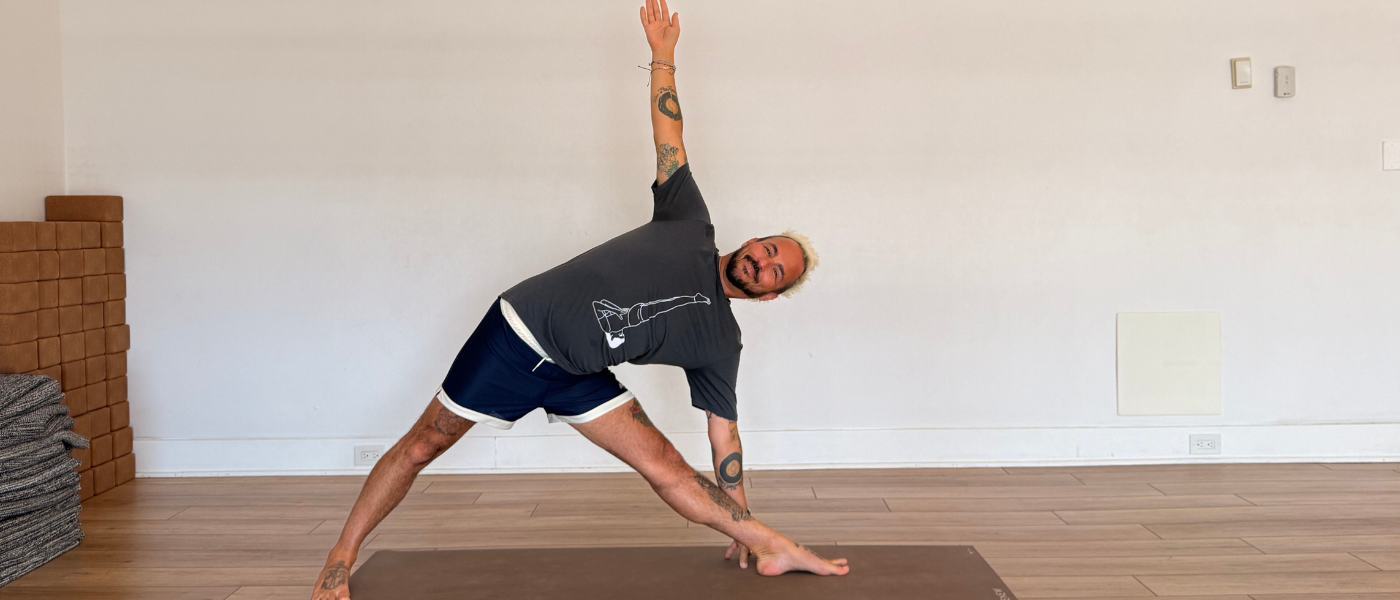
Have you ever stood on one leg, reaching your body into a perfect half-moon shape, feeling like you’re about to topple over at any moment? I remember my first time in Ardha Chandrasana (Half Moon Pose).
It was a test of balance, strength and focus, but as I held the pose I felt calm and clear, like everything in my body and mind had aligned.
It’s an experience I know many yoga practitioners have—and one that has many physical and mental benefits.
What is Ardha Chandrasana?
Ardha Chandrasana, or Half Moon Pose, is a standing balance asana in modern yoga, from the Sanskrit:
- Ardha – half
- Chandra – moon
- Asana – pose
This beautiful and challenging pose mimics the shape of a crescent moon, giving a lovely stretch while strengthening the body.
Practicing Ardha Chandrasana involves balancing on one leg, with the other lifted parallel to the floor, one hand on the ground (or a block) and the other arm up.
Related>>> An interview on me on YOGI TIMES
The etymology and history of ardha chandrasana
The name Ardha Chandrasana comes from Sanskrit, with Ardha meaning “half”, Chandra meaning “moon” and Asana meaning “pose”.
The term refers to a balanced pose in the shape of a half-moon, both symbolizing the calm and cooling qualities of the moon and the strength required to hold the pose.
Historically the name Ardha Chandrasana has had different meanings. For example the 19th century text Sritattvanidhi used it to describe a different pose (Vrikshasana, or Tree Pose).
Related>>> Check out my 200 Hour online YTT
Swami Yogesvarananda in his 1970 book First Steps to Higher Yoga referred to it as a pose similar to Kapotasana (Pigeon Pose). But the modern practice popularized by B.K.S. Iyengar in his 1966 book Light on Yoga is what most people today recognize as the Half Moon Pose.
How to do ardha chandrasana (Step by step)
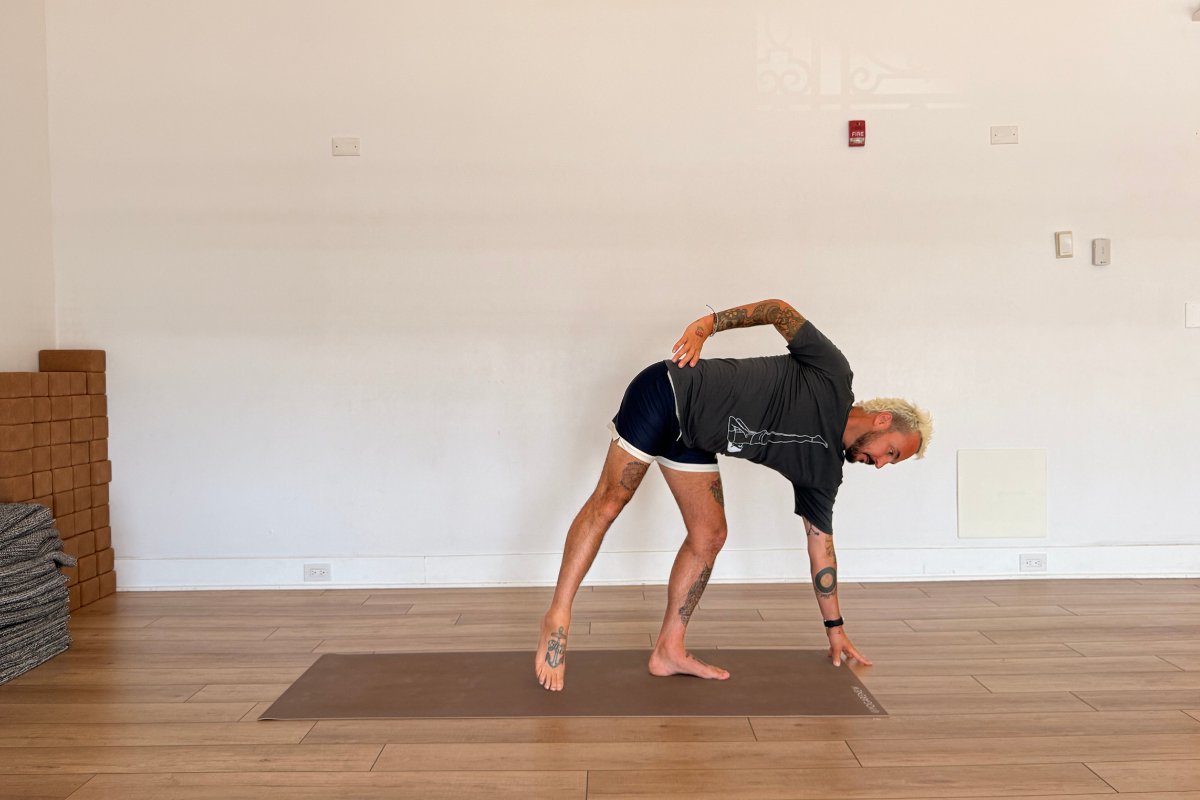
Ardha Chandrasana can be entered from Triangle Pose (Trikonasana). Here’s how to do it:
- Start in Warrior II (Virabhadrasana II): With your left foot forward, bring your hands parallel to the ground.
- Shift Weight to Front Leg: Move your weight into your front leg and start to lower your fingertips to the ground, either on the mat or on a block.
- Lift the Back Leg: Use the strength of your outer hip to lift your back leg, making sure it’s parallel to the ground.
- Align the Hips: Keep your hips open and aligned with the ground, turn your chest up as you extend your top arm up.
- Engage Core Muscles: Balance by drawing your core in and looking at your top hand.
- Adjust the Standing Leg: If needed, slightly bend the knee of your standing leg to create a stable base.
- Find Your Balance: Once stable, hold for several breaths before slowly coming out of the pose.
Variations:
- Parivrtta Ardha Chandrasana (Revolved Half Moon Pose): Twist your body towards the standing leg.
- Baddha Parivrtta Ardha Chandrasana (Bound Revolved Half Moon Pose): A more advanced version where the arms are bound around the standing leg.
Modifications and props for ardha chandrasana
Ardha Chandrasana can be tricky, especially for beginners or those with limited flexibility. But using props and making a few adjustments can make this pose more accessible while still giving you the benefits of balance and strength. Here are some options to modify the pose for you:
- Using a Block:
- If you can’t reach the ground with your hand, place a block under your bottom hand. This will reduce the strain on your lower back and keep your body more aligned.
- Start with the block at its highest setting. As you get more balanced, you can lower the block to the middle and then the lowest setting.
- Wall Support:
- Practice Half Moon Pose near a wall for support. Place your lifted foot against the wall to help stabilize the pose as you get used to balancing on one leg. * This can also be a reference point to help you place your leg more parallel to the ground.
- Practice Half Moon Pose near a wall for support. Place your lifted foot against the wall to help stabilize the pose as you get used to balancing on one leg. * This can also be a reference point to help you place your leg more parallel to the ground.
- Knee Down Variation:
- If you can’t balance, you can modify the pose by keeping one knee on the ground. This will take some of the strain off your standing leg while still allowing you to stretch and strengthen the body.
- If you can’t balance, you can modify the pose by keeping one knee on the ground. This will take some of the strain off your standing leg while still allowing you to stretch and strengthen the body.
- Using a Chair:
- If you can’t balance in this pose, try using a chair for support. Place your lifted leg on the back of the chair while you focus on lifting your chest and extending your top arm to the sky.
These modifications so everyone can benefit from Half Moon Pose while working on balance and alignment.
Common issues in Ardha Chandrasana
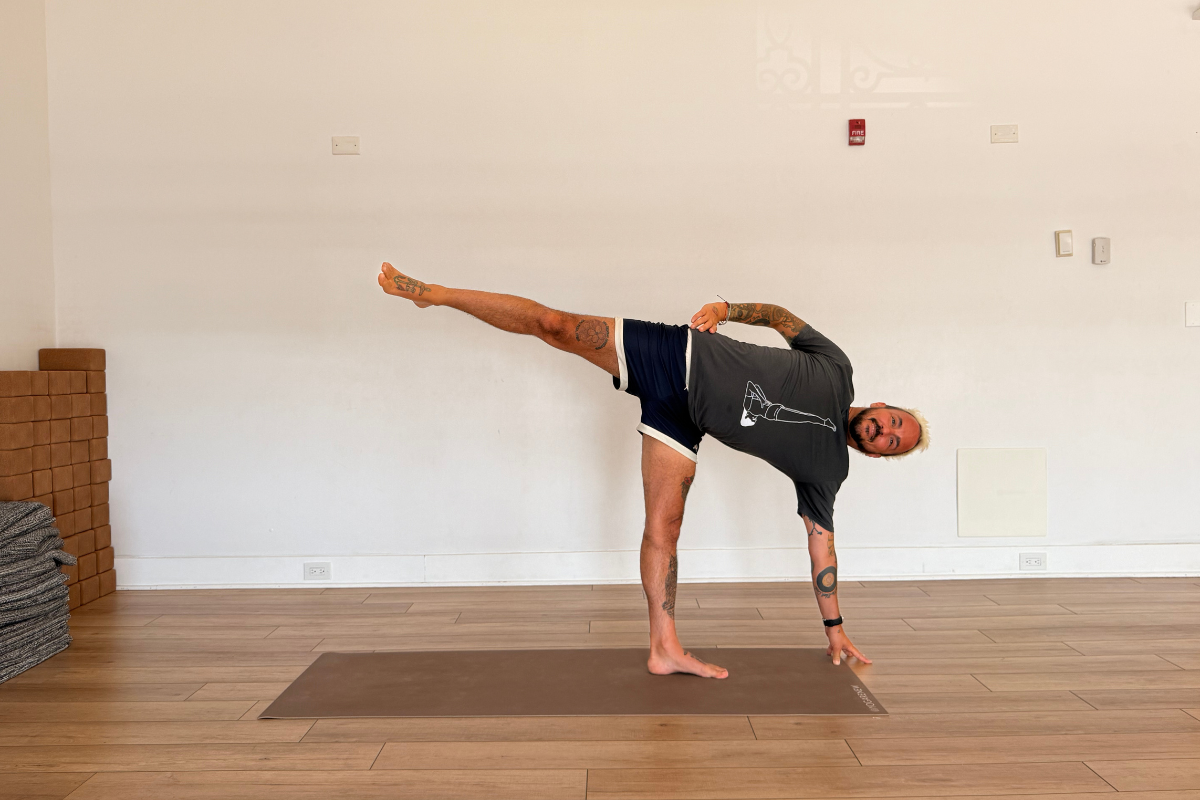
As simple as Ardha Chandrasana may look, it can be tricky. Here are some common problems and solutions:
- Balancing:
- Balancing is one of the main challenges in Half Moon Pose. Beginners often struggle to keep the lifted leg parallel to the ground while keeping the gaze steady.
- Tip: Keep a slight bend in the standing leg to create a more stable base. Engage your core and gaze at a fixed point, either on the ground or at the lifted hand.
- Balancing is one of the main challenges in Half Moon Pose. Beginners often struggle to keep the lifted leg parallel to the ground while keeping the gaze steady.
- Misaligned Hips and Shoulders:
- One of the most common alignment mistakes is allowing the chest and shoulders to twist too much, causing the hips to misalign and the back leg to drop.
- Tip: Stack your hips on top of each other and avoid rotating the chest down towards the ground. Instead, gently rotate your upper body towards the ceiling to open the chest and align the hips.
- One of the most common alignment mistakes is allowing the chest and shoulders to twist too much, causing the hips to misalign and the back leg to drop.
- Lower Back Strain:
- If the bottom hand is too far away from the body or the back leg is not engaged, it can cause lower back strain.
- Tip: Engage your core and don’t collapse into the lower back. If needed, use a block under your hand to reduce the distance between your hand and the ground, to align the spine.
- If the bottom hand is too far away from the body or the back leg is not engaged, it can cause lower back strain.
- Tight Hamstrings or Hips:
- Some practitioners may experience tightness in the hamstrings or hips when trying to lift the back leg.*
Tip: Practice hamstring stretches and hip openers before attempting the pose. Poses like Trikonasana (Triangle Pose) or Vrksasana (Tree Pose) can help open the hips and stretch the legs.
- Some practitioners may experience tightness in the hamstrings or hips when trying to lift the back leg.*
Benefits of Ardha Chandrasana (Half Moon pose)
Ardha Chandrasana has many benefits for both physical and mental aspects of yoga practice. Here are some of the advantages of including Half Moon Pose in your practice:
- Improves Balance and Coordination:
- The main benefit of Ardha Chandrasana is to improve balance and coordination. By balancing on one leg and reaching in opposite directions, you challenge your body to build strength and stability.
- The main benefit of Ardha Chandrasana is to improve balance and coordination. By balancing on one leg and reaching in opposite directions, you challenge your body to build strength and stability.
- Strengthens Key Muscle Groups:
- Core Strength: Ardha Chandrasana requires core engagement to balance. The obliques, rectus abdominis and lower back muscles are all involved.
- Legs and Feet: The pose strengthens the standing leg, especially the thighs, ankles and feet. It also tones the lifted leg, targeting the abductors, quadriceps and calves.
- Hip Flexibility: This pose stretches and strengthens the hip flexors, groin and hamstrings – especially good for athletes like runners or cyclists who often have tightness in these areas.
- Core Strength: Ardha Chandrasana requires core engagement to balance. The obliques, rectus abdominis and lower back muscles are all involved.
- Stretches the Upper Body:
- Ardha Chandrasana opens the chest, shoulders and ribcage which can help to relieve tension from sitting at desks or computer screens all day. The pose also stretches the hamstrings and glutes.
- Ardha Chandrasana opens the chest, shoulders and ribcage which can help to relieve tension from sitting at desks or computer screens all day. The pose also stretches the hamstrings and glutes.
- Mental Clarity:
- As a balancing pose, Ardha Chandrasana requires concentration, focus and mindfulness. Maintaining balance while lifting the back leg and extending the arms requires full body awareness which can help to clear the mind and reduce stress.
- As a balancing pose, Ardha Chandrasana requires concentration, focus and mindfulness. Maintaining balance while lifting the back leg and extending the arms requires full body awareness which can help to clear the mind and reduce stress.
- Detoxifies the Body:
- The twisting variation of Ardha Chandrasana (Parivrtta Ardha Chandrasana) helps to stimulate digestion and detoxify the body by massaging the internal organs and deep twisting.
Counter poses to Ardha Chandrasana
After a challenging pose like Ardha Chandrasana, it’s important to counterbalance the body. Here are a few counter poses:
1. Uttanasana (Standing Forward Bend)
- A gentle forward bend to release tension in the back and legs after the intense stretch in Half Moon Pose.
- Prasarita Padottanasana (Wide-Legged Standing Forward Bend)
- This pose opens the hamstrings and hips, releasing any tension in the lower body that may have accumulated from balancing on one leg.
- This pose opens the hamstrings and hips, releasing any tension in the lower body that may have accumulated from balancing on one leg.
- Child’s Pose (Balasana)
- A resting pose to recover, release any remaining tension in the back, hips and shoulders.
The anatomy of Ardha Chandrasana: Engaging and stretching the full body
Ardha Chandrasana (Half Moon Pose) is a full body pose that engages multiple muscle groups from core to legs, hips and upper body. Here’s a breakdown of the muscles worked and the actions involved:
- Standing Leg.
- Glutes and Hip Abductors: As you lift the back leg, the gluteus medius and minimus engage to lift the leg and stabilize the pelvis.
- Quadriceps and Hamstrings: The standing leg is slightly bent, engaging the quadriceps and hamstrings to hold the leg in place and balance.
- Calves: The calf muscles in the standing leg help to stabilize the body and maintain alignment.
- Glutes and Hip Abductors: As you lift the back leg, the gluteus medius and minimus engage to lift the leg and stabilize the pelvis.
- Lifted Leg.
- Hip Flexors: The hip flexors (rectus femoris and sartorius) are activated to lift the leg and maintain its parallel to the ground.
- Abductors and Quadriceps: The abductors in the lifted leg (gluteus medius and minimus) help to keep the leg extended outwards and the quadriceps to straighten the knee.
- Calf and Foot Muscles: Flexing the lifted foot ensures active engagement through the calf and ankle, creating a stronger foundation.
- Hip Flexors: The hip flexors (rectus femoris and sartorius) are activated to lift the leg and maintain its parallel to the ground.
- Core Muscles
- Abdominals (obliques) are essential to keep the torso aligned and prevent the back from arching. The core muscles provide stability and help to twist the torso upwards. *
The lower back muscles (erector spinae) support the spine and help to lift and engage the torso, while the rectus abdominis helps with balance and alignment.
- Abdominals (obliques) are essential to keep the torso aligned and prevent the back from arching. The core muscles provide stability and help to twist the torso upwards. *
- Upper Body and Arms:
- Shoulders: The muscles of the shoulder girdle (deltoids, rotator cuffs and serratus anterior) help to stabilize the upper body. Engaging the serratus anterior helps to keep the shoulder blade away from the spine and aids in the reach of the top arm.
- Chest: The chest muscles (pectoralis major and minor) are engaged as you twist the torso to open the chest to the ceiling. This helps to prevent the upper body from collapsing and intensifies the stretch across the chest and shoulders.
- Shoulders: The muscles of the shoulder girdle (deltoids, rotator cuffs and serratus anterior) help to stabilize the upper body. Engaging the serratus anterior helps to keep the shoulder blade away from the spine and aids in the reach of the top arm.
- Head and Neck:
- The head and neck remain neutral or turn to gaze upwards or forward, depending on your level of balance and comfort. Engaging the neck muscles helps to keep the head in alignment with the rest of the body.
Variations of Ardha Chandrasana (half moon pose)
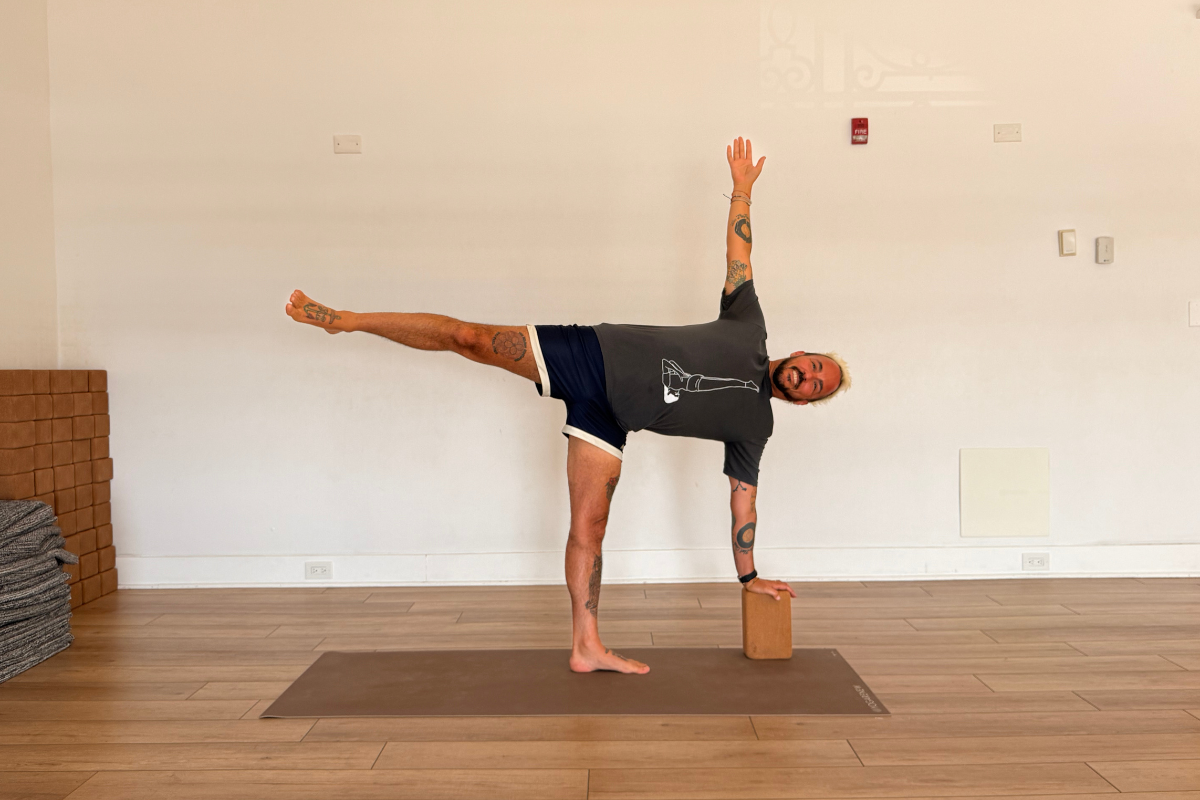
Ardha Chandrasana can be modified in many ways to make it more accessible or more challenging. Here are a few variations:
- Parivrtta Ardha Chandrasana (Revolved Half Moon Pose)
- This variation involves twisting the torso towards the standing leg. The lower hand reaches the ground or a block, while the upper arm extends upwards.
This twist engages the core more, stretches the spine and improves flexibility in the upper back and shoulders.
- This variation involves twisting the torso towards the standing leg. The lower hand reaches the ground or a block, while the upper arm extends upwards.
- Baddha Parivrtta Ardha Chandrasana (Bound Revolved Half Moon Pose)
- A more advanced version, Baddha Parivrtta Ardha Chandrasana combines the Revolved Half Moon with an arm bind.
The arms wrap around the standing leg, deepening the twist and stretching the chest and shoulders. This variation requires more flexibility and strength in the shoulders and hips.
- A more advanced version, Baddha Parivrtta Ardha Chandrasana combines the Revolved Half Moon with an arm bind.
- Ardha Chandra Chapasana (Sugar Cane Pose):
* In this variation, after you reach the classic Half Moon Pose, you bend the lifted leg and reach back to grab the foot with the top hand.
This action pulls the foot towards your glutes, creating a gentle backbend that opens the chest and engages the core.
This variation adds an extra layer of balance, flexibility and strength, especially for the quadriceps, hips and shoulders. - Half Moon Pose on a Chair:
- For those with limited flexibility or looking for a milder version of the pose, try placing a hand or forearm on the seat of a chair.
This modification reduces strain on the back and hips, making the pose more accessible while still challenging the legs and core.
- For those with limited flexibility or looking for a milder version of the pose, try placing a hand or forearm on the seat of a chair.
- Half Moon Pose with Knee Down:
- A modification that focuses more on strength rather than balance, where one knee stays on the ground while the other leg is lifted. The shin of the bottom leg extends behind like a kickstand.
This variation is good for building strength and stability in the lower body.
- A modification that focuses more on strength rather than balance, where one knee stays on the ground while the other leg is lifted. The shin of the bottom leg extends behind like a kickstand.
- Ardha Chandrasana on the Wall:
- Practicing Ardha Chandrasana against a wall for support can make you feel more secure as you lift your leg and extend your arms. The wall can be a support for your lifted foot and guide your leg’s alignment.
Ardha Chandrasana: a mindful practice for strength and balance
As you practice Ardha Chandrasana, you’ll see how important mindfulness, balance and alignment are. This pose is an opportunity to deepen your yoga practice by cultivating patience, coordination and concentration.
While Half Moon Pose challenges your balance, it also strengthens key areas of your body, flexibility, mental clarity and sense of grounding.
The benefits go beyond the physical too. Ardha Chandrasana requires focus, calmness and awareness of breath. As you balance on one leg, stretching one arm up and the other down, there’s an inherent practice of being present in the moment.
The pose asks you to face challenges with grace and patience—just like in life. When you stumble, just like in yoga, it’s about finding your breath and resetting your focus.
Health benefits of Ardha Chandrasana
Ardha Chandrasana is not only a physically demanding pose but also has health benefits that go beyond flexibility and balance. Here are some additional health benefits of practicing this pose:
- Improves Posture:
- Ardha Chandrasana opens the chest which is good for those who sit for long hours especially at desks or in front of computers. The pose encourages upright posture and counters the slouching that comes from poor sitting habits.
- Ardha Chandrasana opens the chest which is good for those who sit for long hours especially at desks or in front of computers. The pose encourages upright posture and counters the slouching that comes from poor sitting habits.
- Stabilizes the Spine:
- The balance and twisting in Ardha Chandrasana activates the muscles along the spine and helps to stabilize the back.
As the chest opens and the body lengthens you improve spinal mobility which is good for those with tight backs or sedentary lifestyle.
- The balance and twisting in Ardha Chandrasana activates the muscles along the spine and helps to stabilize the back.
- Boosts Circulation:
- The standing balance and gentle twist in the body (if you choose the variation) stimulates the circulatory system.
The twist in Parivrtta Ardha Chandrasana improves blood flow, detoxifies the organs and can aid in digestion by stimulating the digestive organs.
- The standing balance and gentle twist in the body (if you choose the variation) stimulates the circulatory system.
- Enhances Mental Clarity and Focus:
- By requiring intense concentration to balance Ardha Chandrasana trains the mind to focus. It clears mental fog and improves concentration.
This focus can carry over into daily life and promotes mindfulness and present-moment awareness.
- By requiring intense concentration to balance Ardha Chandrasana trains the mind to focus. It clears mental fog and improves concentration.
- Relieves Tension and Stress:
- As with many yoga poses Ardha Chandrasana has stress-relieving effects. The physical exertion combined with steady breathing activates the parasympathetic nervous system which is responsible for relaxation and recovery.
This makes the pose good for reducing anxiety and stress after a busy day.
- As with many yoga poses Ardha Chandrasana has stress-relieving effects. The physical exertion combined with steady breathing activates the parasympathetic nervous system which is responsible for relaxation and recovery.
Counter poses to Ardha Chandrasana
After a challenging pose like Ardha Chandrasana it’s important to balance the body and release the built-up tension. Counter poses restore alignment and provide gentle stretches to release the spine, legs and hips.
- Uttanasana (Standing Forward Bend):
- Benefits: Uttanasana is a good counter pose for Ardha Chandrasana. The forward bend releases tension in the hamstrings and lower back and calms the nervous system.
* How to do it: Stand with feet hip-width apart, fold forward and reach for the floor or your ankles. Let your head and neck relax and let the weight of your upper body stretch the back of your legs.
- Benefits: Uttanasana is a good counter pose for Ardha Chandrasana. The forward bend releases tension in the hamstrings and lower back and calms the nervous system.
- Prasarita Padottanasana (Wide-Legged Forward Fold):
- Benefits: This wide-legged forward bend opens the inner thighs, hamstrings and hips. It also releases tension in the back after a deep balance pose.
- How to do it: Stand with feet wide apart and fold forward, bringing your hands to the floor or a block. Keep your legs straight, engage the muscles of your thighs and let your head drop towards the floor.
- Benefits: This wide-legged forward bend opens the inner thighs, hamstrings and hips. It also releases tension in the back after a deep balance pose.
- Child’s Pose (Balasana):
- Benefits: Child’s Pose is a restorative pose that stretches the back, hips and thighs. It relaxes the body and restores calm after the intensity of balancing poses.
- How to do it: Kneel on the floor, sit back on your heels and lower your chest to the ground, extend your arms forward. Breathe deeply and let your body fully relax in this restorative pose.
- Benefits: Child’s Pose is a restorative pose that stretches the back, hips and thighs. It relaxes the body and restores calm after the intensity of balancing poses.
- Supta Baddha Konasana (Reclining bound angle Pose):
- Benefits: This pose opens the hips and relaxes the lower back. After engaging the legs and core in Half Moon Pose this gentle stretch is much needed for the pelvis and inner thighs.
- How to do it: Lie on your back, bring the soles of your feet together and let your knees drop out to the sides. Rest your hands on your belly or by your sides and focus on deep, restorative breathing.
- Benefits: This pose opens the hips and relaxes the lower back. After engaging the legs and core in Half Moon Pose this gentle stretch is much needed for the pelvis and inner thighs.
- Savasana (Corpse Pose):
- Benefits: Savasana is the ultimate counter pose for all yoga sequences. It gives your body a chance to absorb the benefits of the practice and relax completely.
- How to do it: Lie flat on your back, arms by your sides, palms facing upward. Close your eyes, let go of any tension and focus on your breath. This pose allows your body to reset and restore after more intense physical work.
- Benefits: Savasana is the ultimate counter pose for all yoga sequences. It gives your body a chance to absorb the benefits of the practice and relax completely.
Ardha Chandrasana in your practice
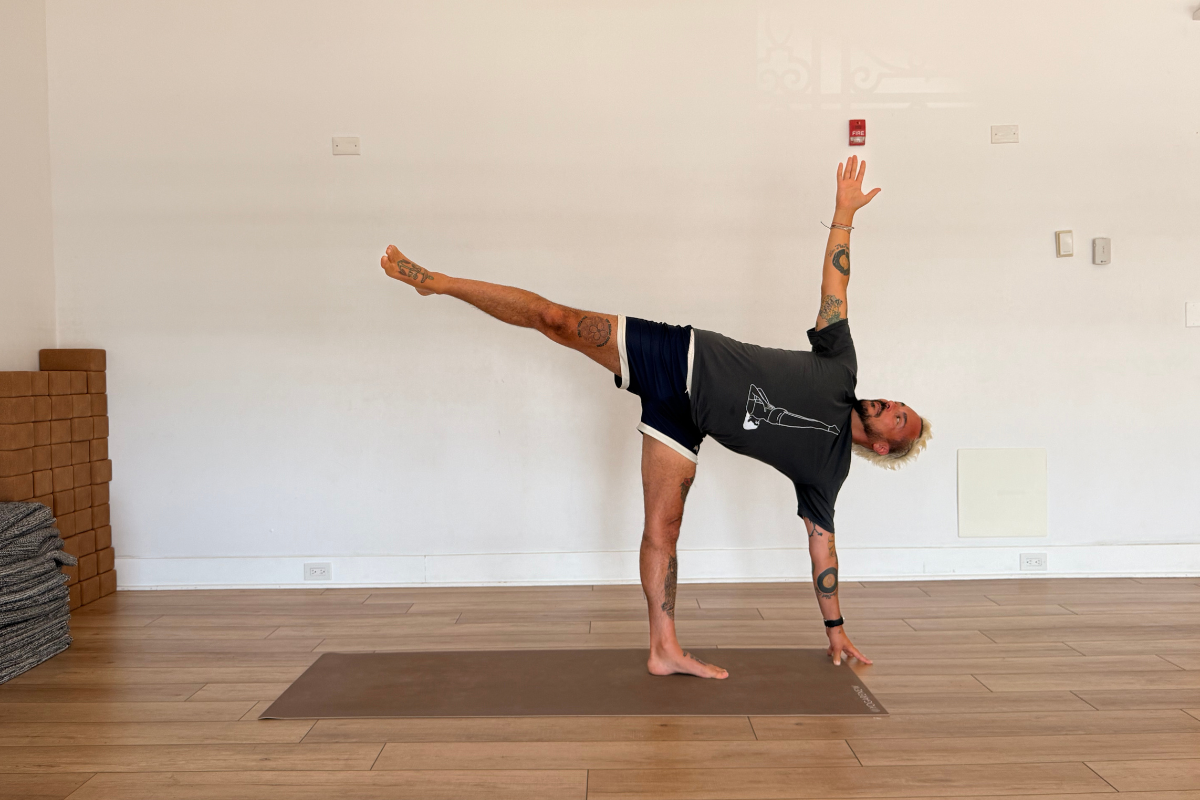
Ardha Chandrasana can be used in different parts of your yoga practice. Here are some sequencing ideas:
- Preceding Poses:
- Utthita Trikonasana (Extended Triangle Pose): A natural precursor to Ardha Chandrasana, Utthita Trikonasana opens the hips and stretches the legs preparing the body for balance.
- Virabhadrasana II (Warrior II): The grounding and strengthening benefits of Warrior II make it an excellent lead-in to Half Moon Pose. This foundational pose prepares the legs, hips and shoulders for the balancing challenge ahead.
- Utthita Trikonasana (Extended Triangle Pose): A natural precursor to Ardha Chandrasana, Utthita Trikonasana opens the hips and stretches the legs preparing the body for balance.
- Sequencing Ideas:
- Warm-Up Sequence: Start with a few gentle poses to open the hips and hamstrings, such as Adho Mukha Svanasana (Downward-Facing Dog) and Utthita Trikonasana.
Move into Virabhadrasana II, then flow into Ardha Chandrasana on the right or left side. Finish with counter poses like Prasarita Padottanasana or Uttanasana. - Standing Sequence: After warming up the legs and hips sequence a series of standing poses that incorporate balance, such as Vrksasana (Tree Pose) and Warrior III (Virabhadrasana III).
Then transition into Ardha Chandrasana to challenge your balance and coordination. - Core-Focused Sequence: Start with core-strengthening poses like Plank and Navasana (Boat Pose). Follow up with standing poses like Warrior II and Utthita Trikonasana.
Then build up to Ardha Chandrasana to fully engage the core while testing your balance.
- Warm-Up Sequence: Start with a few gentle poses to open the hips and hamstrings, such as Adho Mukha Svanasana (Downward-Facing Dog) and Utthita Trikonasana.
- Restorative Sequence:
- If you’re looking for a restorative practice you can place Ardha Chandrasana towards the end of your sequence, after more grounding poses.
After the pose include relaxing counter poses like Supta Baddha Konasana and Child’s Pose to soothe and stretch the body.
- If you’re looking for a restorative practice you can place Ardha Chandrasana towards the end of your sequence, after more grounding poses.
Tip: Start with a block or wall for support as you build strength and confidence in the pose. As you get more comfortable practice without props to challenge your balance.
Be patient with yourself and embrace the challenge. Each time you fall out of the pose simply reset, focus and try again!
Ardha Chandrasana in your daily practice
Ardha Chandrasana or Half Moon Pose is a pose that combines strength, balance, flexibility and focus in yoga. Whether you want to improve your physical practice or cultivate more mental clarity this pose can help you with both.
With regular practice you will not only strengthen your body but also increase your awareness and mindfulness on and off the mat.

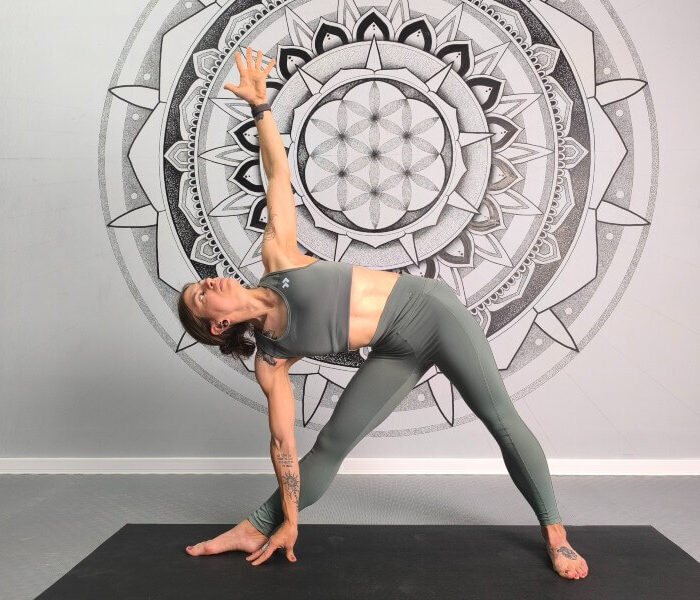
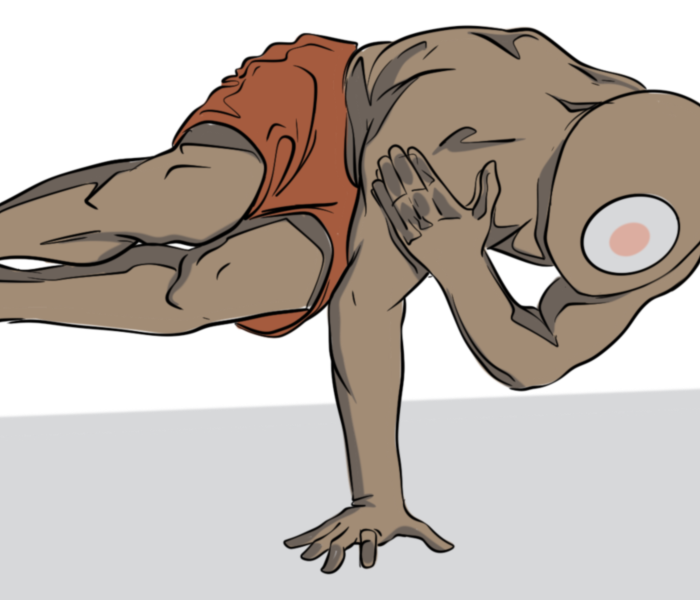
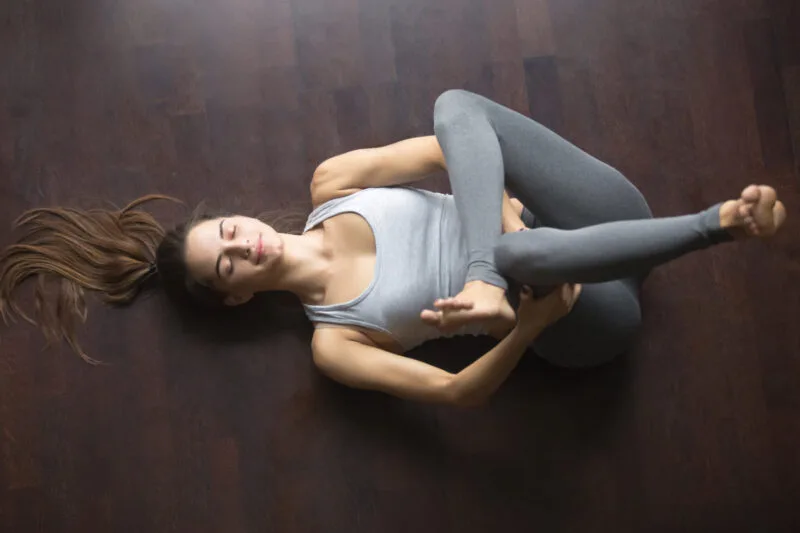


I love how you tied the symbolism of the moon—cooling, calming—with the strength it takes to hold the shape. That duality is exactly what I feel in the pose.
The twisting variation is intense! I wobbled all over the place but afterwards my spine felt like it got a reset. Definitely one to practice more often.
Reading this made me realize how much stress I carry in my chest and shoulders. When I opened up in the pose today, it honestly felt like an emotional release too.
I appreciate that you didn’t make it sound effortless. This pose is hard, even for people who practice a lot, and normalizing the struggle helps me not feel like a failure.
For me, Half Moon Pose is a metaphor for life balance—always shifting, sometimes messy, but if I keep breathing and adjusting, I eventually find my center.
The reminder to engage the lifted foot was gold. I usually let it flop, but when I flexed it intentionally, my balance felt way stronger.
I’ve avoided this pose because of my tight hips, but after trying the chair version you suggested, it actually felt doable. So glad I didn’t just write it off as impossible.
My teacher always says Ardha Chandrasana is “about expansion in all directions.” Reading your description, I finally understood what she meant—stretching up, down, back, forward all at once.
I’ve been practicing for years, but the variation with the wall was new to me. Tried it yesterday and it gave me such a clear sense of how to lift the back leg correctly.
Loved seeing the anatomy breakdown. I’m a nerd about muscles and it makes so much sense now why my outer hip is always sore the next day 😂
For me, Half Moon Pose is like meditation with my eyes open. When I catch the balance, everything else gets quiet for a moment. It’s kind of magical.
This article reminded me that yoga isn’t just about the big flashy poses. Even something “simple” like Half Moon can work the entire body and sharpen the mind if you do it mindfully.
I loved that you mentioned the “fall and reset” approach. Half Moon is literally teaching me patience every single time. And honestly, some days it’s just hilarious how many times I topple.
The tip about keeping a slight bend in the standing leg is genius. I was always locking my knee out and wondering why I couldn’t stay balanced more than two seconds.
I’m a runner and my hamstrings are constantly stiff. Using a block in Ardha Chandrasana like you suggested took so much pressure off my back—I could finally hold the pose without wobbling.
Thank you for including counter poses! I usually forget to balance things out after Half Moon and then wonder why my lower back feels tight. Child’s Pose after really made a difference.
This was the first balancing pose I ever fell out of repeatedly 😅 but after reading your breakdown, I realize I was totally ignoring my core. Tried again today with that in mind and it felt much steadier.
I love that you mentioned the volunteers and how it wasn’t just free labor but an actual exchange where people thrived. That’s such a beautiful reminder that work can be fulfilling and regenerative if the intention behind it is right. I think many of us crave being part of something like that.
Wow, I had no idea Half Moon Pose had so much history behind it. I always thought it was just another balance pose, but learning how the meaning evolved over time (even being confused with Tree Pose in the past!) makes me appreciate it more.